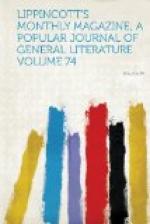The second king, still called King George Washington, is now about thirty, and a most noble specimen of the courtly Oriental gentleman. His tall, compact figure is admirably developed both for strength and beauty, his face is full and pleasing, and his head finely formed. He is affable in manner, converses readily in English, and is fond of Europeans and their customs. He keeps his father’s palace and steamboats in excellent condition, and his body-guard under thorough drill. On a recent visit of the American steamer Moreton he came out on the battlements of his palace, and after watching her progress for some time, he signaled her to lay to, which she did just opposite his palace. He immediately went aboard, and remained for an hour or so, chatting merrily with both ladies and gentlemen, while the steamer puffed up the river a few miles, and then returned for His Majesty to disembark at his own palace. King George occasionally wears the full English dress, either civil or military, but generally only the hat, coat, linen and shoes, with the Siamese pah-nung in lieu of pantaloons. The regent, the minister of foreign affairs and many of the princes and nobles have adopted this mongrel costume, and, to a greater or less extent, our language, manner of living and forms of etiquette. Visitors to the kings now sit on chairs, instead of crouching on cushions before the throne, as formerly; while native princes and ministers of state no longer prostrate themselves with their faces in the dust in the royal presence, but stand at the foot of the throne while holding an audience with their Majesties, each being allowed full opportunity to state his case or present any petition he may desire. The sovereigns are no longer unknown, mysterious personages, whose features their people have never been permitted to look upon; but they may be seen any fine day taking their drives in their own coaches or phaetons, and lifting their hats to passing friends. Nor do they on ordinary occasions deem it necessary to be surrounded by armed soldiers for protection, but go where they list, with only their liveried coachmen and footmen, and perhaps a single companion or secretary inside.
The city itself has correspondingly improved. Within the walls have just been completed two new streets, meeting at right angles near the mayor’s office, where is a public park of circular form very handsomely laid out. The streets radiating from this centre are broad, and lined with new brick houses of two stories and tiled roofs. These are mostly private dwellings, uniformly built; and with their broad sidewalks and shade trees of luxuriant tropical growth present a very picturesque appearance. One wide street, commencing at the royal palace, extends six or seven miles through the city, reaching the river near a little village called Pak-lat-bon. This is the fashionable drive, where may be seen not only their Majesties, the regent, the prime




